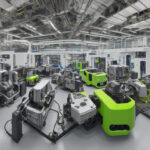Korean Scientists Unveil Breakthrough in Energy Storage Technology
Seoul, Korea — June 22, 2025 — A team of scientists from the Korea Institute of Science and Technology (KIST) has made a significant advancement in energy storage technology with the development of a next-generation supercapacitor. This innovative device promises to overcome longstanding limitations of current energy storage systems, potentially transforming applications in electric vehicles, drones, and wearable technology.
Addressing Energy Storage Challenges
Led by Dr. Bon-Cheol Ku and Dr. Seo Gyun Kim from KIST, along with Professor Yuanzhe Piao from Seoul National University, the research team has engineered a high-performance supercapacitor that combines single-walled carbon nanotubes (CNTs) with a conductive polymer known as polyaniline (PANI). Traditional supercapacitors are known for their rapid charging capabilities and high power density; however, they suffer from lower energy density, which has limited their practical applications.
"We developed this technology to enhance both the energy and power density of supercapacitors simultaneously, a challenge that has hindered their widespread use in applications requiring sustained energy output," said Dr. Ku.
Innovative CNT-PANI Fiber Structure
The research introduces a novel fiber structure composed of CNTs bonded with PANI at the nanoscale. This design facilitates improved movement of electrons and ions, resulting in a supercapacitor capable of storing more energy while providing faster discharge rates. Preliminary tests indicate that this new supercapacitor can maintain stable performance for over 100,000 charge and discharge cycles, making it viable for high-demand environments.
The unique structure allows for a composite fiber that not only demonstrates excellent energy and power density but can also withstand high voltage conditions. This durability holds promise for advancements in various technologies, particularly electric vehicles, where faster charging could enhance driving range and overall performance.
Mass Production and Commercial Viability
One of the major hurdles in the commercialization of CNTs has been their high production costs. However, the research team has successfully addressed this challenge by integrating the low-cost polymer PANI into the composite structure. This breakthrough reduces manufacturing expenses and allows for mass production. The researchers developed fiber bundles ranging from single-stranded to 300-stranded fibers, maintaining specific capacitance across the board, showcasing the versatility of the material.
The mass production process is designed to ensure the scalability of this technology, enabling it to adapt across different applications. The researchers have also successfully developed film-like structures based on the same technology, positioning this innovation for commercial utilization.
Future Implications
The implications of this breakthrough extend beyond just electric vehicles and drones. With its flexibility and lightweight properties, the CNT-PANI composite fiber is poised to redefine energy storage in next-generation electronics, including wearable devices. The versatility of the technology equips it to contribute significantly to the transition towards a carbon-neutral society.
"This technology represents a significant leap forward in the development of supercapacitors, overcoming their traditional limitations and offering unprecedented performance," said Dr. Ku. "We are committed to further developing and industrializing ultra-high-performance carbon fibers derived from carbon nanotubes."
The findings of this research have been published in the journal Composites Part B: Engineering and have led to domestic and U.S. patent applications, highlighting the initiative’s commitment to advancing energy storage solutions. The project received funding from the Ministry of Science and ICT and the Ministry of Trade, Industry and Energy, underscoring the support for innovative research in Korea.
This exciting development in energy storage technology could very well lay the groundwork for a new era of efficient and durable energy systems, as industries continue to seek solutions that meet the increasing demands for energy efficiency and sustainability.










